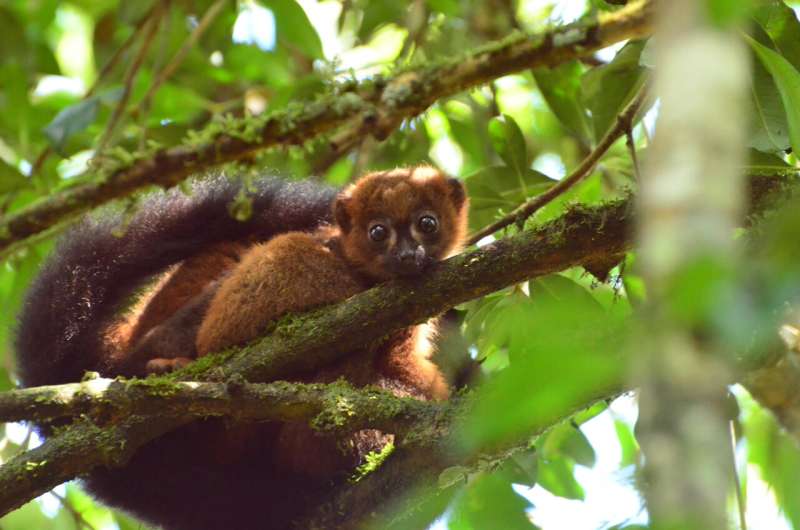This article has been reviewed according to Science X's editorial process and policies. Editors have highlighted the following attributes while ensuring the content's credibility:
fact-checked
peer-reviewed publication
trusted source
proofread
Protecting just 0.7% of world's land could help save a third of unique and endangered species

Conservation efforts directed towards just 0.7% of the world's land mass could help protect one third of the world's threatened and unique tetrapod (four-limbed vertebrate) species, new research by Imperial College London, On the Edge, and ZSL has shown.
The study, led by researchers at Imperial College London and published this week in Nature Communications, finds that large gains in conservation are possible by focusing on areas home to exceptional biodiversity and species with high levels of evolutionary distinctiveness and global endangerment.
These endangered species include animals like the aye-aye, a highly distinctive lemur found in Madagascar; the long-legged and eagle-bodied secretary bird; the purple frog, which has a nose similar to a pig; and the gharial, a long-snouted and critically endangered crocodile found in the Indian subcontinent.
At present, however, just 20% of the areas identified in the study are under some form of protection, with most areas facing consistent and increasing levels of human pressure.
Lead author Sebastian Pipins, a Ph.D. candidate at the Grantham Institute, Imperial College London, said, "Our research highlights the regions of the world that are of immediate concern. Furthermore, it shows that in protecting just a fraction of the Earth's land surface, huge gains can be made for the preservation of nature."
On the edge of extinction
The project identified specific areas of conservation interest with exceedingly high levels of threatened evolutionary history that are marked by their concentration of Evolutionarily Distinct (ED) and Globally Endangered (GE) species.
Evolutionary distinctiveness quantifies how unique a species is, with some being the result of long periods of unique evolutionary history with few or no close living relatives. Meanwhile, global endangerment reflects the extinction risk of a species. Species that score highly on both measures are known as EDGE species, while the areas in which these species are found in high concentrations are referred to as EDGE Zones.
Pipins added, "It is crucial to not just consider species diversity in conservation efforts, but also the evolutionary history of diversity, to ensure that large and unique branches from the tree of life are not lost."
Zones of interest
The study mapped the distribution of almost 3,000 EDGE species, identifying 25 EDGE Zones where conservation efforts can have the greatest impact.
Specific areas of EDGE species richness include large parts of Southeast Asia and the Indo-Gangetic plain, the Amazon basin and the Atlantic Forest, as well as in Hispaniola, the highlands of Cameroon, and the Eastern Arc mountains of East Africa.
The authors found maximum richness within an area of less than 100-square kilometers in Madagascar, which, along with Mexico and Indonesia, contained the highest number of EDGE species.
Underlining the critical importance of national leadership to support conservation efforts, the research also found that 75.6% of EDGE species exist within a single country.
Co-author Dr. Rikki Gumbs, from the ZSL's EDGE of Existence program, said, "Three-quarters of the world's most unique animals are able to call only one country home, meaning that action from individual nations will go a long way to protect these incredible species from extinction."
Very large areas of Southeast Asia have higher levels of EDGE species, which the researchers say reflects how the looming biodiversity disaster in this region is impacting the highly unique and wide-ranging species found within.
Human factors
The scientists also found that the vast majority of EDGE Zones face high levels of human disturbance and that the human populations found within many EDGE Zone countries face deprivation in education, health, and living standards.
Dr. Gumbs added, "We're currently in the midst of a biodiversity crisis, driven by unsustainable use of natural resources; it's shocking but not surprising that 80% of the zones we identified are under high levels of pressure from human activity.".
Given these challenges, governments' limited resources are often prioritized for dealing with human deprivation, leaving less for biodiversity conservation.
Pipins said, "Given the global importance of the biodiversity found within these regions, high-income countries must mobilize funding to facilitate sustainable development that can benefit both humans and nature."
Global goals
Just 20% of EDGE zones are under some form of protection. As countries look to protect 30% of land and sea by 2030, as per the Convention on Biological Diversity's target, the authors call for the unprotected portions of EDGE Zones to be prioritized.
Dr. Gumbs said, "With the COP16 Biodiversity Conference on the horizon, we need to see world leaders from across the globe scaling up their commitments and resources to support these efforts and restore the natural world that we all rely on."
The researchers argue that their findings demonstrate that large gains of biodiversity are possible with relatively small additions to globally protected areas. They also argue that their research offers the potential for extending the EDGE Zone approach to other important groups of wildlife, such as plants and fish.
Using EDGE zone research
The EDGE Zones identified in this research will guide the activities of the charitable organization On the Edge, directing their conservation grant-making, regional campaigns, and grantee-led storytelling.
They will also form part of the decision-making for resource allocation for ZSL's EDGE of Existence program, with a particular focus on the Gangetic Plains and Cameroon.
More information: Sebastian Pipins et al, Advancing EDGE Zones to identify spatial conservation priorities of tetrapod evolutionary history, Nature Communications (2024). DOI: 10.1038/s41467-024-51992-5
Journal information: Nature Communications
Provided by Imperial College London



















